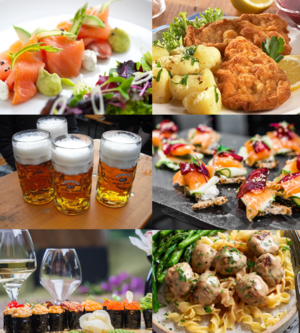Acrean cuisine
Acrean cuisine is the cuisine of Acrea, consisting of dishes, ingredients, cooking methods, and traditions from Acrea. Acrean cuisine is composed of a wide variety of regional and local cuisines reflecting Acrea's wide climate range, and its rich and diverse cultural history. As part of the wider Nordic cultural region of Eracura, Acrean cuisine shares some similarities with the national cuisines of neighbouring Nordic states such as Nordkrusen and Delkora, but retains unique twists, flavours, and techniques as a consequence of its geographic diversity and cultural influences.
Acrea is also well known for its immense production and vast selection of alcohols. Beer, wine, cider, and mead are all incredibly popular throughout the country, with beer and mead being predominant in most regions with the exception of Acrean Venetia, where wine is more popular. It is estimated that among Acrea's approximately 3,000 breweries, there are nearly 7,000 varieties of beer brewed in Acrea nationwide with a wide selection of regional varieties. While beer, cider, and mead breweries are located all over the country, wine production is centered primarily in Acrea's central and southern agricultural regions. A wide variety of wines are produced, many of which are considered unique to Acrea and protected by place of origin laws. The most common varieties of red wines produced are pinot noir and cabernet sauvignon, while the most common variety of white wine is riesling. Acrean spirits are likewise popular, with gin, akvavit, brandies, and rum having the largest share of domestic distillers.
One of the earliest known Acrean recipe collections was the 6th century Um emnið att Matreiðsla (On the Subject of Cooking), written by Audo Evorikssen, a gourmet of the Late Imperial era. Later recipe collections and cookbooks from the 8th century onwards have provided culinary historians with a clear evolution and development of Acrean cuisine over time.
Beginning in the 1400s, Acrean society began to see the development of haute cuisine, distinguished from regular cuisine not by who could eat but rather in the nature of its preparation. Although dedicated chefs had existed since antiquity in Acrea, it wasn't until the establishment of the country's first dedicated culinary schools in Savoy and Baden in 1436 and 1440 respectively that truly professionally trained chefs became commonplace in the courts and estates of Acrean society. Culinary arts had long been considered a trade alongside those such as carpentry and masonry, however where these professions had long had their own dedicated institutions, culinary arts had not. Professional chefs quickly became a staple amongst higher society, with chefs taking up positions not simply as the head of their estate's kitchen but also serving as the individual in the household staff responsible for planning lavish events such as parties, feasts, and weddings. "High" cuisine became known as such because of the meticulous planning, deliberately selected ingredients, use of extravagant presentation, and complex cooking techniques which was used by these chefs.
Although only the upper class were able to truly afford exotic ingredients or the extravagance that professional chefs had become known for in late Imperial Acrea, most aspects of traditional haute Acrean culinary techniques, flavour profiles, and presentation have long since trickled down to be widely accessible due to their pervasiveness within culinary education in Acrea. Like other trades, there was little cost associated with attending school, and so aspiring chefs of different socioeconomic backgrounds could attend, widely disseminating culinary knowledge across Acrea.
National Cuisine
Regional Cuisine
The complexity and specific sort of ingredients of dishes varies with region; most coastal regions of Acrea are known for simplicity in their cuisine, and make use of fresh, simple ingredients and seafood (especially fish such as salmon and tuna), often complemented with citrus. Dishes from Acrea's inland regions and alpine areas tend to be heavier and more spiced, making use of heavier proteins such as beef, lamb, or pork. Aside from its haute tradition, Acrean cuisine is perhaps best known abroad for a few exported staples; its vast array of cured meats and sausages, and chocolate treats from its alpine chocolatiers.
Foods and Ingredients
Acrea's size and vary climate, from its warm mediterranean coast along the Sundering Sea in the south to its cool temperate north, has resulted in a vast and diverse array of ingredients being widely available to chefs across the country. Acrean cuisine is traditionally centered around protein, of which there is a great variety. Beef, veal, pork, lamb, chicken, squab, and duck are all very common in Acrean dishes, as is seafood. Salmon is a staple food in Acrea. High-quality salmon is inexpensive and widely available, as both saltwater and freshwater varieties are fished and farmed in abundance.
The varying climate and thus growing regions has historically provided a wide variety of produce at relatively low cost. While Acrean regional cuisines tend to use locally grown herbs, fruits, and vegetables, some ingredients such as citrus fruits that are regionally grown are found almost universally amongst regional cuisines. Potatoes and onions are often considered Acrean cuisine's staple vegetables, as they are widely used in all regions in a variety of dishes regardless of other local produce. Locally grown fungi is also commonly used, with both foraged and farmed mushrooms being a popular ingredient. Truffles, which grow only in Venetia, are a much less common but prized ingredient in high-end Acrean restaurants. Common fruits include peaches, various citrus (such as oranges, lemons, and limes), blackcurrants, apples, grapes, strawberries, and cherries.
